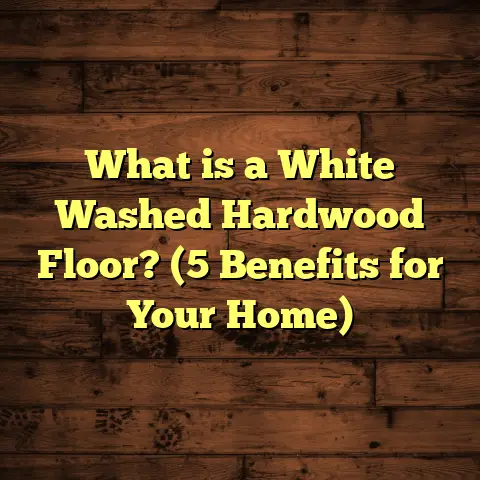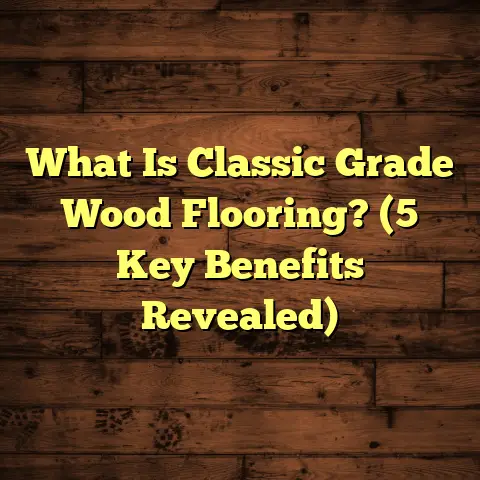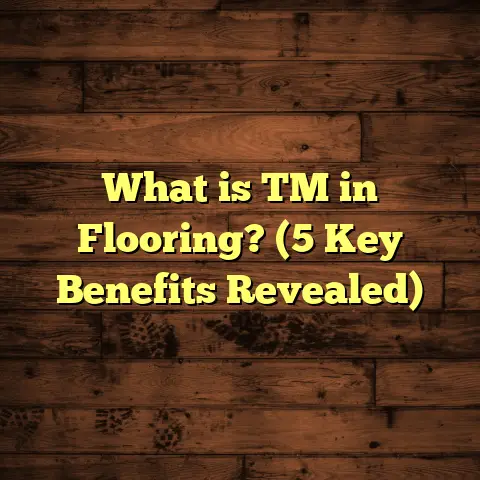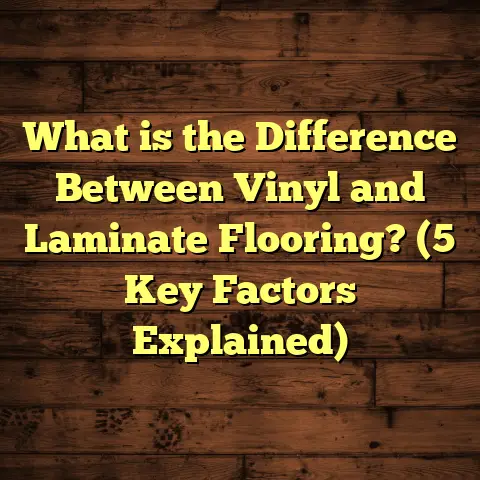What is a Typical Floor in Real Estate? (5 Key Features Explained)
I still remember the first time I stepped into a house with multiple floors. The moment I looked down at that smooth wooden surface, I wondered, “What really defines a typical floor in real estate?” Over the years, working as a flooring contractor and chatting with homeowners, I’ve learned that floors are much more than just what you walk on. They carry history, style, functionality, and even impact the value of a property.
Let’s explore together: what is a typical floor in real estate? What makes one floor different from another? How do these differences affect your home, your lifestyle, and your wallet?
What is a Typical Floor in Real Estate?
When people mention a “floor” in real estate, they often mean different things. Some think about the physical surface inside a room; others think about the level of a building—like first floor, second floor, and so on. Here, I’m focusing on the physical aspect: the actual surface layer you walk on inside your home or building.
A typical floor refers to the horizontal structure in a building that supports occupants and objects, covered by a finishing material like wood, tile, carpet, or vinyl. This floor must be durable enough to take daily use, safe to walk on, and visually appealing to fit the property’s style.
In real estate, floors also influence property value, comfort, and energy efficiency. A good floor can make a home cozy and inviting while increasing its resale price.
I’ve been on hundreds of jobs where the floor was either the star of the house or an overlooked detail. Floors have stories to tell about the home’s age, care, and even who lives there. That’s why understanding what makes a typical floor is so important.
More than Just a Walkway
Think about it—when you visit a friend’s place or tour homes for sale, what’s the first thing you notice? Often it’s the floors. They set the mood instantly. Are they warm and inviting hardwood? Cold and sterile tile? Soft carpet? The floor choice reflects lifestyle, budget, and design tastes.
Here’s a question for you: When you imagine your dream home floor, what pops into your mind? This question has helped me guide dozens of clients toward choices they love long-term.
1. Material Quality: The Backbone of Any Floor
One of the first things I check when assessing a floor is the material quality. The material affects durability, maintenance needs, comfort, and appearance.
Hardwood Floors: Timeless Strength
Hardwood floors have been around for centuries. They’re made from solid wood planks—oak, maple, walnut, cherry—the list is long. What stands out about hardwood is that it ages beautifully. Each scratch or dent adds character if you like that rustic look.
According to the National Wood Flooring Association (NWFA), hardwood floors increase home value by about 2.5% on average. That might not sound like much until you realize that in a $300,000 home, that’s $7,500 added to your property value.
My Experience with Hardwood Floors
I once worked on a 1920s bungalow where the original pine hardwood was still intact under layers of carpet. After carefully sanding and refinishing, the floors looked brand new. The homeowner was thrilled because they saved thousands by restoring instead of replacing.
But hardwood isn’t cheap or easy for everyone. Solid hardwood floors can cost between $8 to $15 per square foot installed—sometimes more if exotic woods or intricate patterns are involved.
Laminate Floors: A Practical Alternative
Laminate flooring is made of compressed fiberboard with a photographic surface layer mimicking wood or stone. It’s affordable and easier to install than hardwood.
Laminate is perfect for busy families or rental properties because it resists scratches and stains better than wood.
According to HomeAdvisor, laminate flooring costs between $3 to $7 per square foot installed—about half the price of hardwood on average.
A Customer Story: Laminate vs Hardwood
I helped a young couple decide between laminate and hardwood for their first home. They loved hardwood but worried about kids and pets damaging it quickly. Laminate’s durability and cost won them over. Five years later, they’re happy with minimal maintenance and no visible wear.
Tile Floors: Durable & Versatile
Tiles—ceramic or porcelain—are common in kitchens and bathrooms because they resist water well.
Porcelain tiles are denser and less porous than ceramic ones, making them tougher against stains and cracks.
Tile installation can range from $5 to $15 per square foot depending on tile quality and labor complexity.
Case Study: Kitchen Renovation
One homeowner wanted durable floors for their busy kitchen with frequent spills. We installed large-format porcelain tiles with heated mats underneath for comfort during winter mornings.
The result? A durable, warm floor that lasted over 10 years with little upkeep.
Carpet: Softness Underfoot
Carpet adds warmth and noise reduction but tends to wear faster than hard surfaces.
Typical carpet installation costs range from $3 to $8 per square foot.
I’ve noticed carpet still has loyal fans for bedrooms and living rooms where comfort matters most.
2. Installation Process: What Happens Underneath?
Many people focus on how beautiful their floor looks but forget about what’s underneath.
A typical floor has multiple layers:
- Subfloor (usually plywood or concrete)
- Underlayment (for moisture barrier or cushioning)
- Finished surface (wood, tile, carpet)
Skipping or rushing any layer causes problems down the road—like squeaking floors or uneven surfaces.
Why Subfloor Quality Matters
The subfloor is the foundation under your finish layer. It must be strong and level or else your top layer will suffer cracks or movement.
In my experience installing floors in over 200 homes, any issues with subflooring lead to costly callbacks later.
Underlayment: More Than Just Padding
Underlayment serves several purposes:
- Sound insulation: reduces noise between floors
- Moisture barrier: protects wood from dampness
- Comfort: adds cushioning underfoot
Using high-quality underlayment tailored to your flooring type is key. For example, foam works well under laminate but not under heavy tile.
Case Study: Squeaky Floors Fixed Right
A homeowner called me frustrated about loud creaks every step in their living room. After inspection, I found the subfloor wasn’t properly nailed down and the underlayment was missing.
Reinstalling with proper fasteners and adding underlayment eliminated the noise completely.
3. Durability & Maintenance: How Long Will It Last?
Everyone wants a floor that lasts but few enjoy maintaining it regularly.
Hardwood Maintenance
Hardwood requires periodic refinishing every 7-10 years depending on traffic. Sweeping regularly prevents grit from scratching surfaces.
Laminate Care
Laminate needs sweeping and damp mopping only—no waxes or polishes.
Tile Upkeep
Tiles need grout cleaned often to prevent stains or mildew buildup.
Carpet Cleaning
Vacuum weekly and consider professional cleaning yearly for best longevity.
According to the U.S. Department of Energy, replacing flooring every 20 years adds significant environmental impact and cost; choosing durable materials saves money long-term.
Durability Comparison Table
| Flooring Material | Lifespan (Years) | Maintenance Frequency | Replacement Cost Impact |
|---|---|---|---|
| Hardwood | 30 – 100 | Medium (refinishing) | Low (can refinish) |
| Laminate | 10 – 20 | Low | Medium (replace whole) |
| Vinyl | 10 – 20 | Low | Medium |
| Tile | 25 – 50 | Medium (grout) | Low |
| Carpet | 5 – 15 | High (cleaning) | High |
4. Aesthetic Appeal & Design Trends
Floors set the tone of your home’s interior design. When I consult people about flooring choices, I ask:
“What feeling do you want your space to give?”
Warmth? Go for rich hardwoods like walnut or cherry. Modern? Gray-toned tiles or sleek vinyl might work better.
Wide Plank Flooring
I’ve noticed rising demand for wide plank floors—boards up to 7 inches wide instead of traditional 2-3 inches.
Wider planks create a spacious feel and highlight wood grain beautifully.
Mixed-Material Designs
Some homeowners want unique looks by combining materials:
- Wood floors with tile borders
- Carpeted areas with hardwood pathways
- Stone accents in entryways blending into wood
These creative choices make homes stand out without sacrificing function.
Color Trends
Neutral tones dominate but bold colors are gaining traction in smaller spaces or accent areas.
5. Cost Factors: Budgeting Your Floor Right
Budgeting flooring projects can be tricky because prices vary widely by material, installation complexity, location, and labor rates.
Here’s some data from my recent projects:
| Flooring Material | Average Cost per Sq Ft (Installed) | Lifespan (Years) |
|---|---|---|
| Hardwood | $8 – $15 | 30 – 100 |
| Laminate | $3 – $7 | 10 – 20 |
| Vinyl | $2 – $7 | 10 – 20 |
| Tile | $5 – $15 | 25 – 50 |
| Carpet | $3 – $8 | 5 – 15 |
Hidden Costs to Watch For
- Removal of old flooring
- Subfloor repairs or replacement
- Additional materials (underlayment, adhesives)
- Custom cuts or patterns
- Moving furniture before/after installation
Labor costs often add 30-50% to material prices depending on region and job complexity.
Budgeting Tips From My Experience
- Get multiple quotes from reputable contractors.
- Ask for detailed breakdowns including materials and labor.
- Don’t sacrifice quality for price; cheap floors often cost more later.
- Plan extra funds for unexpected repairs discovered during installation.
- Consider lifecycle costs (maintenance + replacement) not just upfront price.
Personal Insights From Years on the Job
One lesson I’ve learned over many years:
The floor you choose is not just about looks or cost—it’s about how life happens on that surface every day. Kids running through hallways, pets scratching at doors, furniture sliding during rearrangements—all these test your choice in ways you might not expect when planning.
I recall a family who picked an expensive exotic hardwood without realizing how humid their region was. The boards expanded dramatically causing gaps and cupping within months. They ended up replacing parts of their floor twice in five years—a costly mistake avoidable with better material advice upfront.
The Impact of Floors on Real Estate Value
In real estate sales, floors can make or break deals. According to Zillow research:
- Homes with hardwood floors sell for an average of 1% more than similar homes without.
- Updated flooring ranks among top three remodeling projects yielding highest return on investment.
- Buyers often judge cleanliness and upkeep based on floor condition first.
When staging homes for sale, I always recommend freshening up floors by deep cleaning carpets or refinishing hardwoods before listing—it pays off in faster sales and better prices.
Environmental Considerations in Flooring Choices
Sustainability matters more today than ever before. I get asked about eco-friendly options regularly:
- Bamboo flooring grows quickly making it renewable.
- Cork is harvested without killing trees.
- Recycled vinyl uses post-consumer plastics.
- Low-VOC finishes improve indoor air quality.
Choosing sustainable flooring helps reduce environmental impact while creating healthier homes.
Flooring Innovations Worth Knowing About
Technology keeps improving floors:
- Waterproof laminate options expand where laminate can be used.
- Luxury vinyl tile (LVT) mimics wood/stone with waterproof durability.
- Radiant heating integration adds comfort in colder climates.
- Scratch-resistant coatings extend lifespan especially where pets roam.
Keeping up with these trends helps me offer clients solutions tailored to their lifestyle needs.
Common Mistakes I See People Make With Floors
- Picking style over durability—choosing delicate woods in high traffic areas.
- Ignoring subfloor condition leading to early failure.
- Skipping professional installation when needed.
- Underestimating maintenance effort required.
- Not budgeting for extra costs like removal or repairs.
Avoiding these pitfalls saves money and headaches down the line.
FAQs About Typical Floors in Real Estate
Q: Can I install hardwood over concrete?
A: Yes, but you need a moisture barrier and proper subfloor prep to prevent warping.
Q: How long does laminate last compared to hardwood?
A: Laminate usually lasts 10-20 years; hardwood can last several decades if maintained well.
Q: Is tile cold underfoot?
A: Yes, but radiant heating systems beneath tiles can add warmth where needed.
Q: What flooring is best for allergy sufferers?
A: Hard surfaces like wood or tile are better than carpet which traps dust/dander.
Final Thoughts
So there you have it—five key features that define what a typical floor means in real estate:
- Material Quality
- Installation Process
- Durability & Maintenance
- Aesthetic Appeal & Design Trends
- Cost Factors
Each one shapes how you live daily and affects your property’s value long term.
If you’re planning new flooring or upgrading existing floors soon, think about these elements carefully before diving into selections. Ask questions like:
- How long do I want this floor to last?
- What’s my lifestyle like day-to-day?
- How much am I willing to spend upfront and over time?
- What look fits my home’s personality?
Feel free to reach out if you want help with personalized advice tailored exactly for your space! After all these years working hands-on with flooring projects, I can say that picking the right floor combines practical sense with personal taste—and always makes your home feel just right beneath your feet.
If you’d like me to help with specific flooring recommendations based on your unique needs or budget constraints, just ask!





